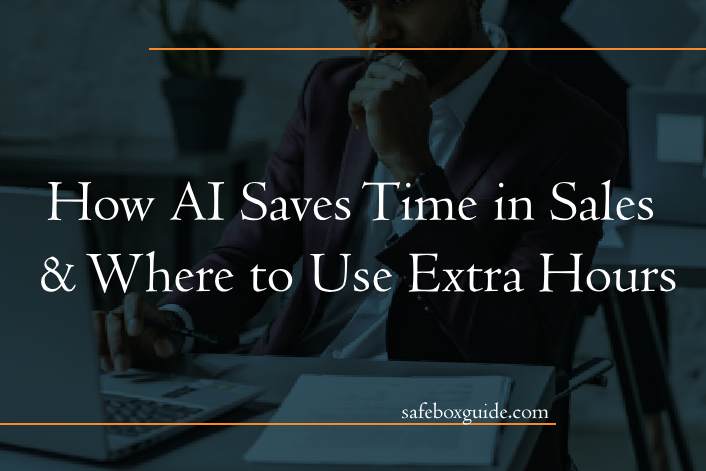Artificial Intelligence (AI) has revolutionized various industries, and sales is no exception. In the world of sales, time is a precious commodity, and maximizing efficiency is crucial for success. With AI-powered tools and technologies, sales teams can now automate repetitive tasks, gain valuable insights, and streamline processes, ultimately saving time and boosting productivity. In this article, we will explore how AI saves time in sales and where sales professionals can best use the extra hours to drive growth and revenue.

Contents
1. Automating Data Entry and Analysis
One of the most time-consuming aspects of sales is data entry and data analysis. Sales representatives often spend countless hours manually entering customer information, updating CRM systems, and generating reports. AI-powered tools can automate these tasks, reducing the burden on sales teams and allowing them to focus on more critical activities.
AI-driven data entry tools can extract relevant information from emails, documents, and other sources, and automatically update the CRM system. Similarly, AI analytics tools can process large datasets quickly, identifying patterns, trends, and customer preferences. This data-driven approach enables sales teams to make informed decisions and prioritize their efforts effectively.
2. Personalized Customer Engagement
AI enables sales teams to personalize their interactions with customers at scale. Through machine learning algorithms, AI can analyze historical customer data, including past purchases, preferences, and behavior. Armed with this knowledge, sales representatives can tailor their communication and offerings to match each customer’s specific needs and preferences.
Personalized engagement not only enhances the customer experience but also saves time for sales representatives. Instead of sending generic, mass emails to a wide audience, AI can help deliver targeted messages to individual customers, increasing the likelihood of engagement and conversion.
3. Lead Scoring and Prioritization
In sales, not all leads are equal. Identifying and prioritizing high-quality leads can be time-consuming and challenging. AI-powered lead scoring systems can automatically analyze customer data, online behavior, and interactions to determine the likelihood of conversion.
By using AI-driven lead scoring, sales teams can focus their efforts on leads with the highest potential for conversion. This approach ensures that sales representatives invest their time and resources in prospects that are most likely to become customers, leading to higher efficiency and improved sales outcomes.
4. Chatbots and Virtual Assistants
AI-powered chatbots and virtual assistants have become essential tools in sales. They can engage with website visitors, answer frequently asked questions, and provide support around the clock. By handling routine inquiries and basic customer service tasks, chatbots free up sales representatives’ time to focus on more complex and high-value activities.
Chatbots can also capture valuable customer information during interactions, helping sales teams to better understand customer needs and preferences. Additionally, they can schedule appointments and set reminders, ensuring that no leads fall through the cracks.

Where to Use Extra Hours
With the time saved through AI-powered sales processes, sales professionals can allocate their efforts to activities that have a significant impact on revenue generation and customer satisfaction. Here are some areas where sales teams can use the extra hours:
1. Building Stronger Customer Relationships
Sales representatives can invest more time in building meaningful relationships with customers. Personalized engagement, follow-ups, and regular check-ins can foster trust and loyalty, leading to repeat business and referrals.
2. Upselling and Cross-Selling
AI can help identify upselling and cross-selling opportunities, but sales representatives are best equipped to execute these strategies effectively. With extra time on their hands, they can focus on upselling complementary products or services to existing customers, increasing the average transaction value.
3. Research and Market Analysis
In-depth market research and competitive analysis are vital for sales success. Sales professionals can utilize the extra time to study market trends, analyze competitors’ strategies, and identify emerging opportunities.
4. Continuous Learning and Skill Development
Sales is an ever-evolving field, and continuous learning is essential to stay competitive. Sales teams can use the extra hours to attend workshops, webinars, and training sessions that enhance their selling skills and keep them updated on industry best practices.
5. Networking and Industry Events
Participating in networking events, trade shows, and industry conferences can open doors to new prospects and partnerships. With more time on their hands, sales representatives can actively engage in such events to expand their professional network.
6. Collaborating with Marketing
Close collaboration between sales and marketing teams is crucial for a cohesive sales strategy. Sales professionals can use their extra time to work closely with marketing teams, providing valuable insights to refine marketing campaigns and target the right audience effectively.
AI has emerged as a game-changer in the sales industry, saving time and improving overall efficiency for sales teams. By automating data entry, providing personalized customer engagement, and assisting with lead scoring, AI enables sales representatives to focus on high-value tasks and strategic activities. With the extra hours gained, sales professionals can build stronger customer relationships, identify upselling opportunities, conduct in-depth market analysis, and invest in continuous learning and skill development. By leveraging AI’s capabilities effectively and using the extra time wisely, sales teams can drive growth, increase revenue, and stay ahead in the competitive marketplace.

